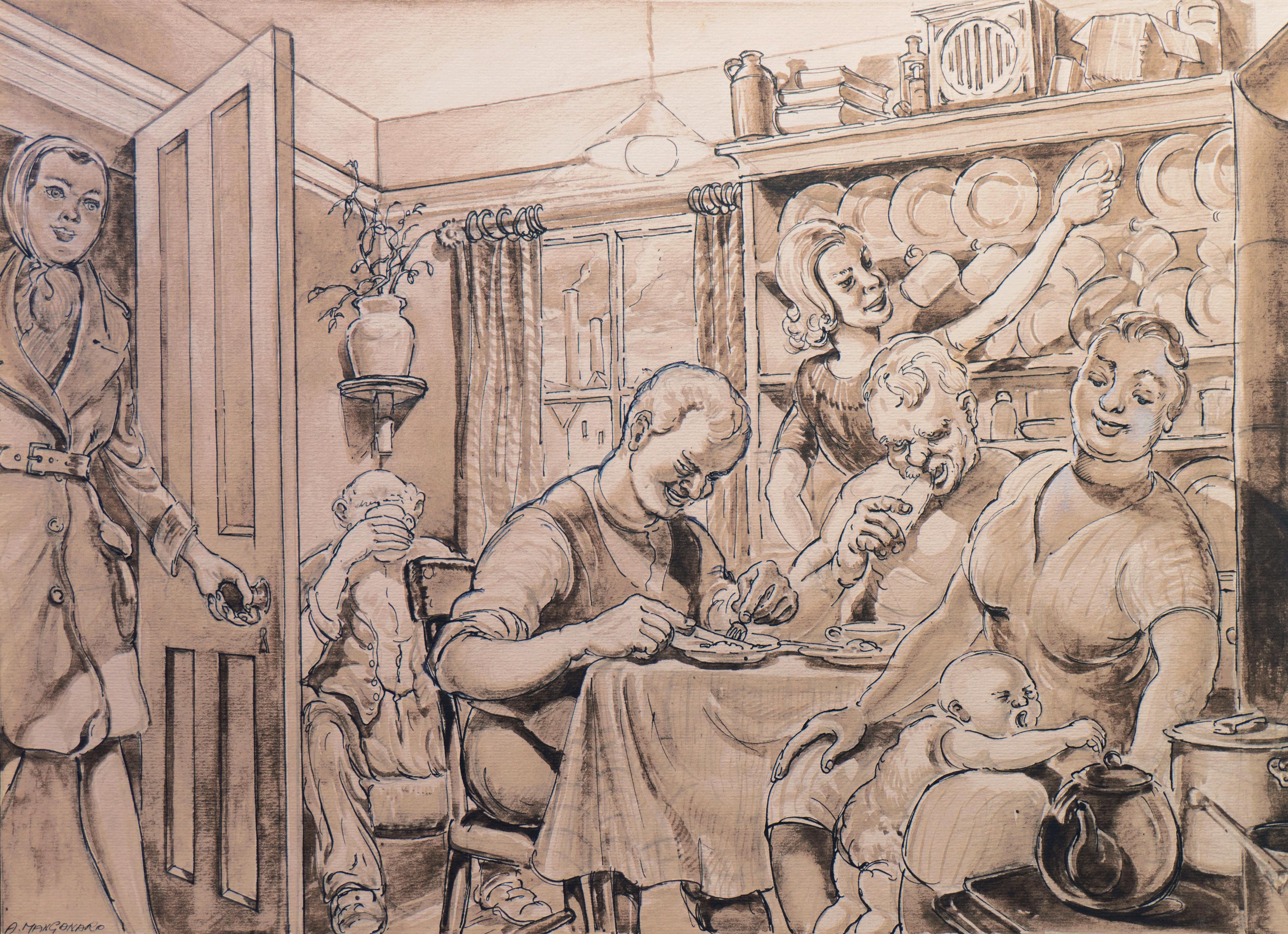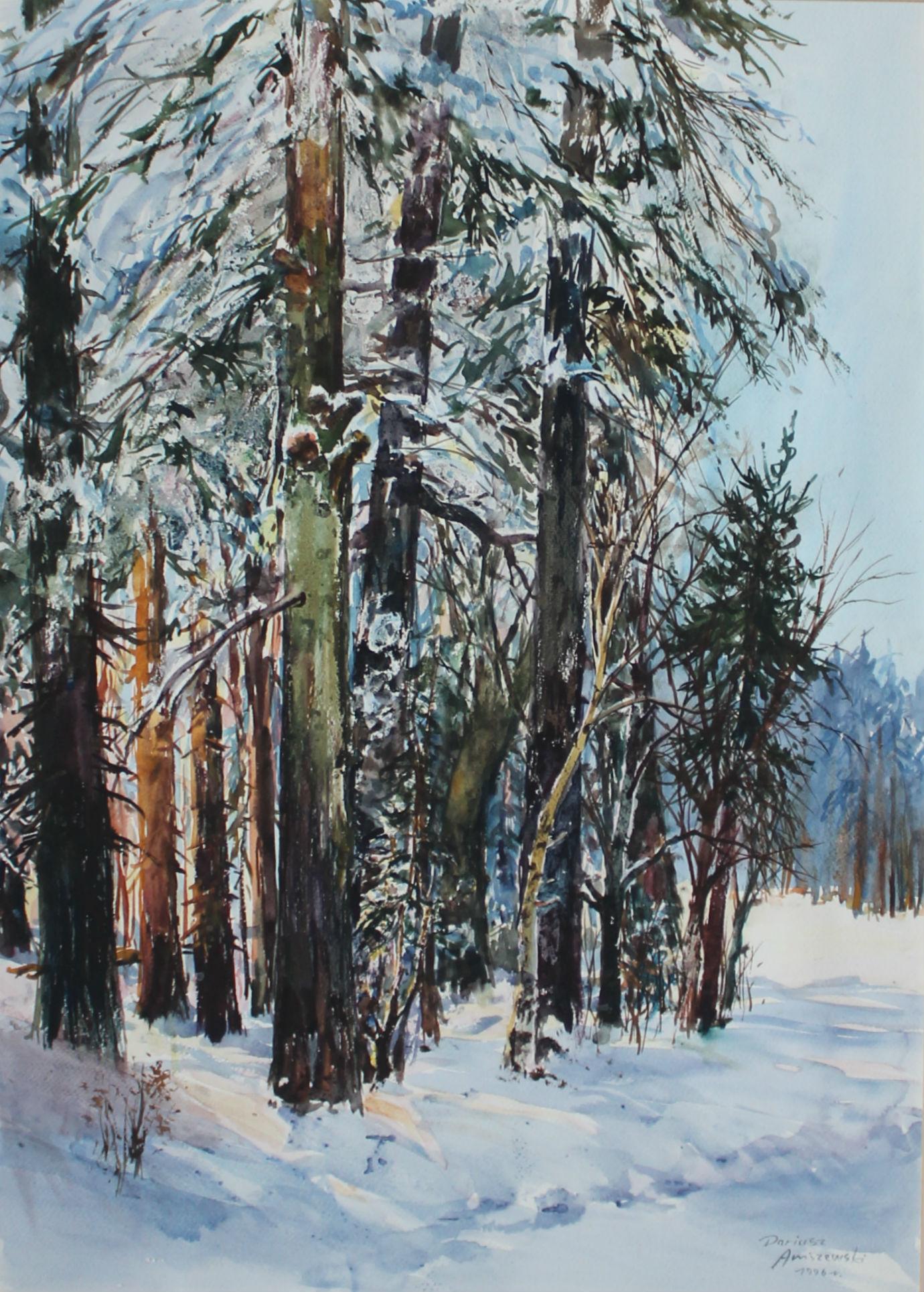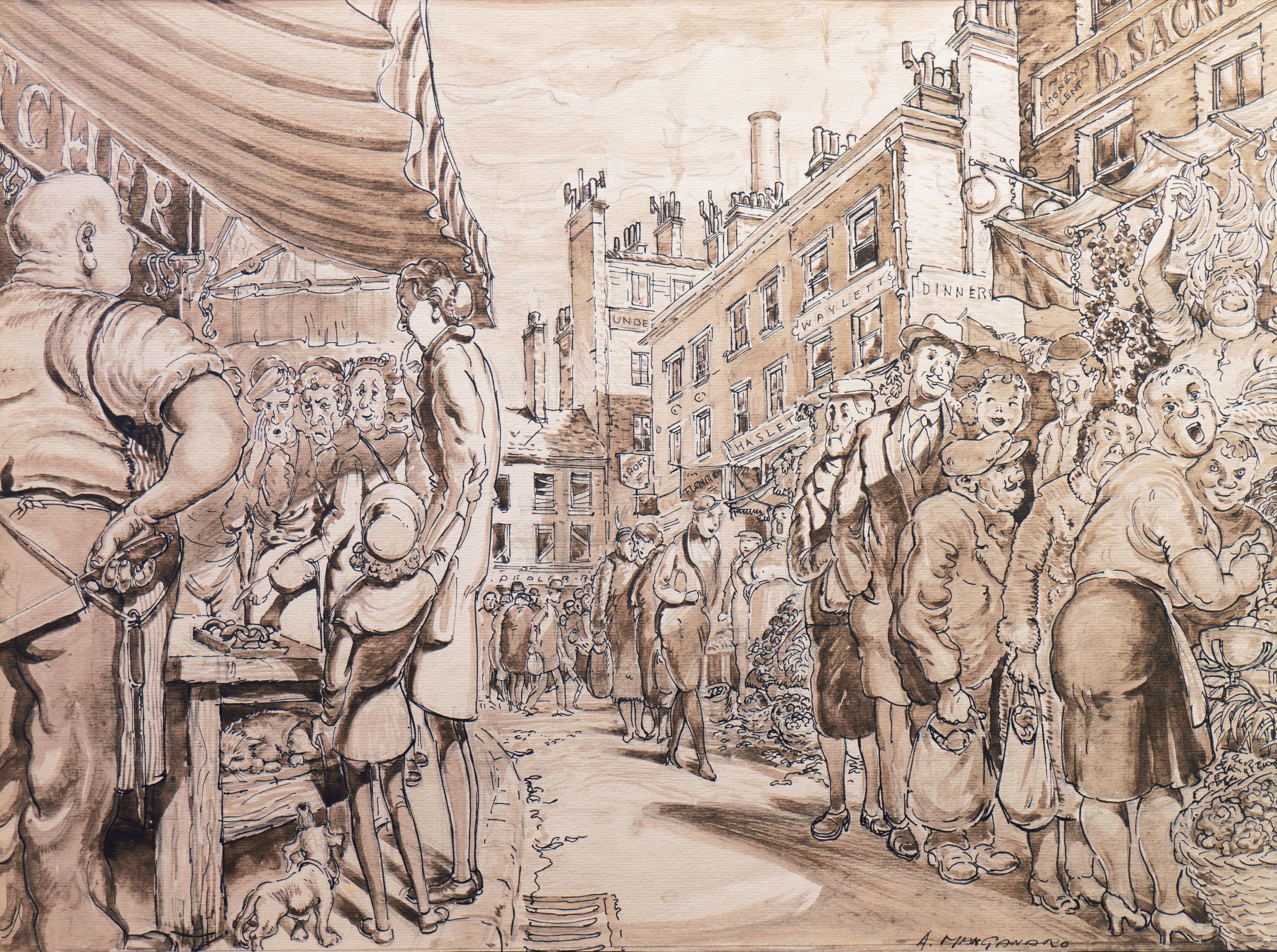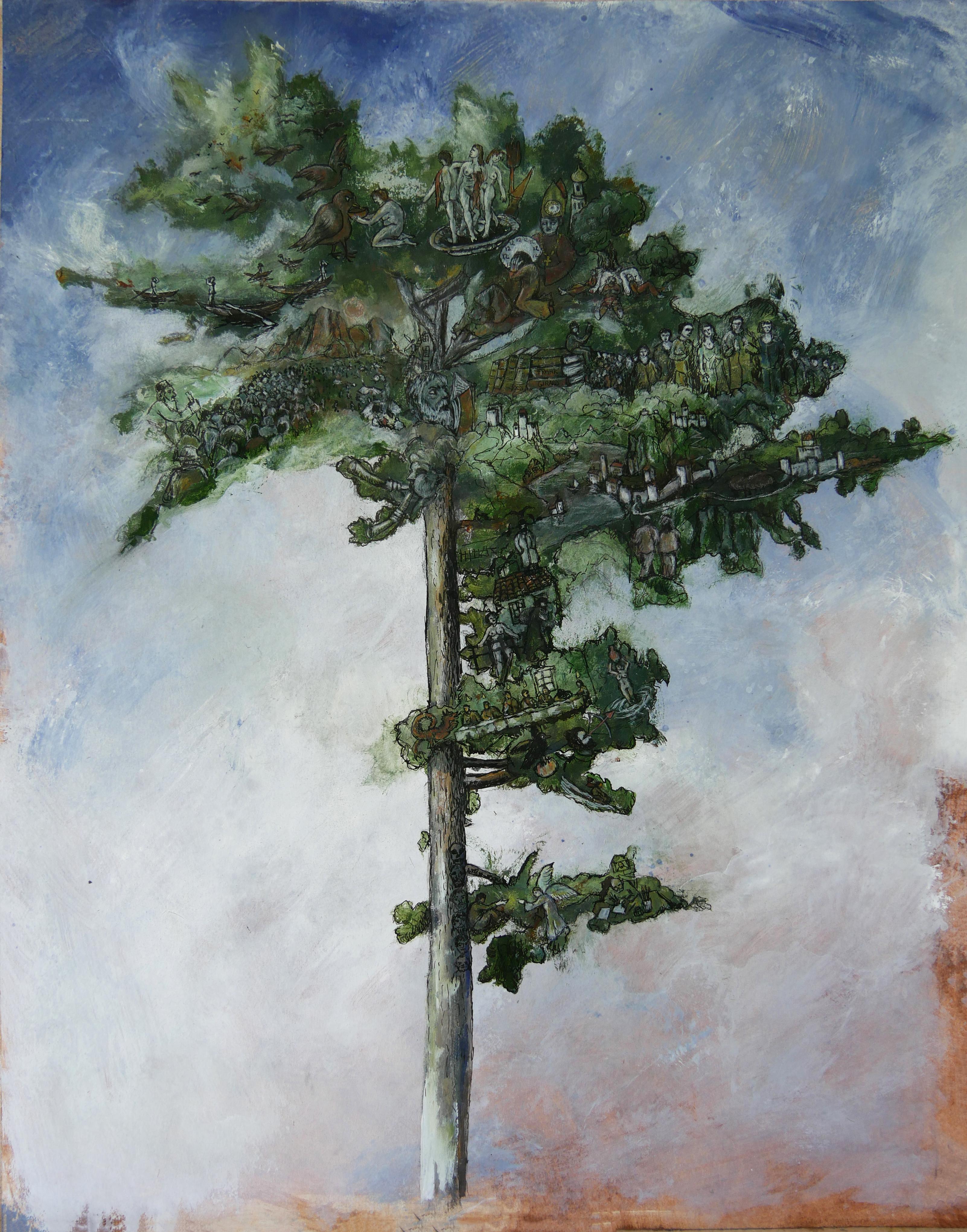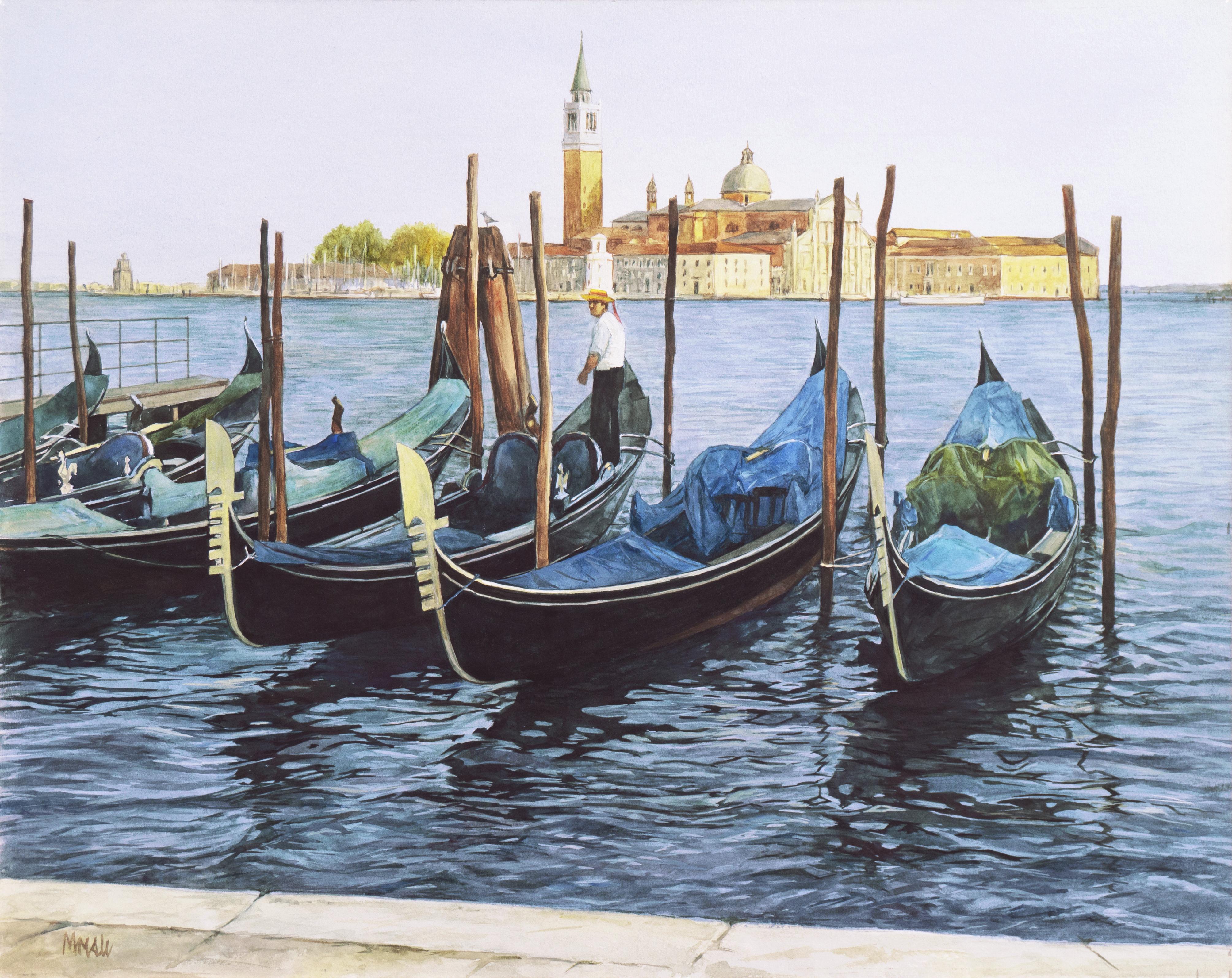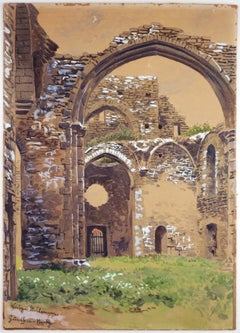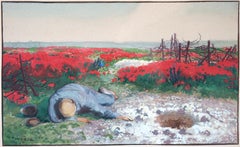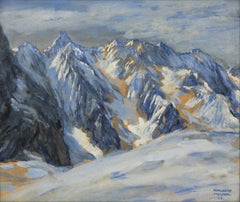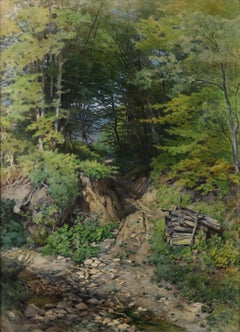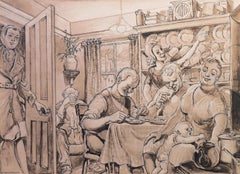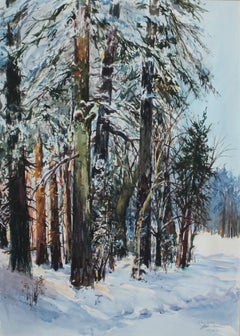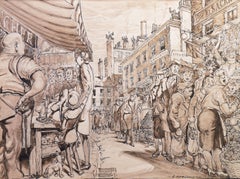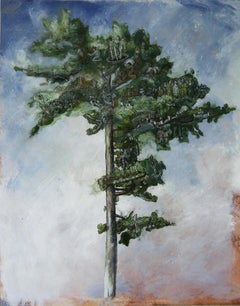Artículos similares a Evening Cottage Scene / - Somewhere in Nowhere -
Cargando vídeo
¿Quieres más imágenes o vídeos?
Solicita imágenes o vídeos adicionales al vendedor
1 de 11
Arthur Claude StrachanEvening Cottage Scene / - Somewhere in Nowhere -
Acerca del artículo
Arthur Claude Strachan (1865 Edinburgh - 1954 Minehead), Evening Cottage Scene. Watercolor on paper, mounted, 28 x 46 cm (visible size), 48 x 65 cm (frame), signed "Claude Strachan." lower left. Framed in passepartout behind glass.
- The watercolor is in good condition, the frame a little rubbed at the corners and with a minor chip.
- Somewhere in Nowhere -
About the artwork
There is a path across the painting that we seem to have come to and will continue to follow. On this walk through the English countryside, we have come upon the cottage at the side of the path and have stepped aside to take a closer look. As invisible observers, we are presented with an evening scene that is all the more characteristic for its casualness, and that tells of the contemplative side of country life, which takes place timelessly away from the hustle and bustle of the city. The chimney of the cottage, which seems to have stood here forever, is smoking, and the door of the house is a little bit open. Apparently, the neatly dressed woman of the house has come out to fetch water to prepare the meal. She will go back inside, and also the ducks are probably on their way to their hutch.
In the direction in which the ducks are moving and in which the path leads, the sky on the horizon is inflamed by the evening red. Evening is approaching, and the whole picture is filled with an evening atmosphere that will pass into the blue hour. Even the water of the stream reflects the reddish sky.
It is in the depiction of the water that Strachan's mastery of watercolor is revealed. Not only is he able to depict both still and moving water, but he is also able to depict the reflections on the water and the water as a transparent medium through which we can view the riverbed.
This technical virtuosity, however, does not stand alone, it is an essential moment of the pervading atmosphere of the picture, to which the flower garden, merging into the 'wild' nature, also contributes. The gate to it is open or missing, which is like an invitation to have a closer look at the flowers and to enjoy the beauty of this cultivated creation. The evening atmosphere is also present here - the sunflowers have already tilted their heads.
The entrance to the cottage is also flanked by flowers, while plants grow from the roof. Together with the thatched roof and the half-timbered walls, the house itself looks like a part of nature, which is further enhanced by the fact that the windows to the left of the entrance reflect like the surface of the water.
The whole scenery could have been taken from William Morris's utopian novel News from Nowhere (1890) and shows that utopia is not utopia but reality.
About the artist
Arthur Claude Strachan studied at the Liverpool Academy of Art and then worked as a watercolorist, capturing rural life far from the hustle and bustle of the city. He traveled extensively throughout Great Britain and lived in Evesham, Wallasey and Minehead.
Strachan's work has been exhibited at the Walker Art Gallery in Liverpool and the Royal Academy in London.
GERMAN VERSION
Arthur Claude Strachan (1865 Edinburgh - 1954 Minehead), Abendliche Landhausszene. Aquarell auf Papier, kaschiert, 28 x 46 cm (Sichtmaß), 48 x 65 cm (Rahmen), unten links mit „Claude Strachan.“ signiert. Im Passepartout hinter Glas gerahmt.
- Das Aquarell ist in gutem Zustand, der Rahmen an den Ecken etwas berieben und mit kleinerer Fehlstelle.
- Irgendwo im Nirgendwo -
zum Kunstwerk
Es führt ein Weg quer durchs Bild, auf dem wir gekommen zu sein scheinen und dem wir weiter folgen werden. Auf diesem Gang durch die englische Landschaft sind wir auf das am Wegesrand liegende Landhaus gestoßen und etwas beiseitegetreten, um es ganz in Augenschein nehmen zu können. Als unsichtbare Betrachter bietet sich uns eine abendliche Szenerie dar, die in ihrer Beiläufigkeit umso charakteristischer ist und von der beschaulichen Seite des Lebens auf dem Lande berichtet, das sich wie zeitlos abseits der Großstadthektik vollzieht. Der Schornstein des scheinbar schon ewig hier stehenden Landhauses raucht und die Tür des Hauses ist einzig angelehnt. Offenbar ist die gepflegt gekleidete Frau des Hauses herausgekommen, um Wasser für die Zubereitung des Essens zu schöpfen. Sie wird wieder ins Haus gehen und auch die Enten sind wohl auf dem Weg zu ihrem Verschlag.
In der Richtung, in welche sich die Enten bewegen und in die der Weg führt, ist der Himmel am Horizont vom Abendrot entflammt. Es geht auf den Abend zu und das ganze Bild ist von einer Abendstimmung erfüllt, die in die blaue Stunde übergehen wird. Selbst auf dem Wasser des Bachlaufs sind Reflexe des rötlichen Himmels zu sehen.
Gerade in der Darstellung des Wassers zeigt sich Strachans meisterliche Aquarellmalerei. Ihm gelingt es nicht allein, gleichermaßen unbewegtes wie bewegtes Wasser zu veranschaulichen, er vermag auch die Reflexionen auf dem Wasser und das Wasser dabei zugleich als durchsichtiges Medium darzustellen, durch welches wir auf das Bachbett schauen können.
Diese technische Virtuosität steht aber nicht für sich, sie ist ein ganz wesentliches Moment der allesdurchwaltenden Bildatmosphäre, zu der auch der in die ‚wilde‘ Natur übergehende Blumengarten beiträgt Die Pforte zu ihm hin steht offen oder fehlt ganz, was einer Einladung gleichkommt, die Blumen näher zu betrachten und sich an der Schönheit dieser kultivierten Schöpfung zu erfreuen. Auch hier ist die Abendstimmung präsent - die Sonnenblumen haben bereits ihre Köpfe geneigt.
Der Eingang zum Landhaus wird ebenfalls von Blumen flankiert, während vom Dach kaskadenartig Schlingpflanzen herabwachsen. Zusammen mit dem Reetdach und dem Fachwerk wirkt das Haus selbst wie ein Teil der Natur, was zusätzlich verstärkt wird, indem die Fenster links vom Eingang wie die Oberfläche des Wassers reflektieren.
Die ganze Szenerie könnte William Morris utopischem Roman Kunde von Nirgendwo (1890) entnommen sein und führt vor Augen, dass die Utopie nicht Utopie, sondern Realität ist.
zum Künstler
Arthur Claude Strachan studierte an der Kunstakademie Liverpool und war anschließend als Aquarellmaler tätig, der in seinen Bildern das Landleben fernab der Großstadthektik festgehalten hat. Dazu bereiste er intensiv Großbritannien und lebte in Evesham, Wallasey und Minehead.
Werke Strachans wurden unter anderem in der Walker Art Gallery in Liverpool und der Royal Academy London gezeigt.
Sobre el vendedor
5,0
Vendedor Oro
Vendedores premium que mantienen una calificación de +4,3 y tiempos de respuesta de 24 horas
Establecido en 2014
Vendedor de 1stDibs desde 2023
17 ventas en 1stDibs
Tiempo de respuesta usual: 6 horas
- EnvíoRecuperando presupuesto…Envío desde: Berlin, Alemania
- Política de devolución
Partes de esta página se han traducido automáticamente. 1stDibs no puede garantizar la exactitud de las traducciones. El inglés es el idioma predeterminado de este sitio web.
Garantía de autenticidad
En el improbable caso de que haya algún problema con la autenticidad de un artículo, ponte en contacto con nosotros en un plazo de 1 año para recibir un reembolso total. DetallesGarantía de devolución de dinero
Si tu artículo no es como se describe, sufre daños durante el transporte o no llega, ponte en contacto con nosotros en un plazo de 7 días para recibir un reembolso total. DetallesCancelación dentro de las 24 horas
Tienes un período de gracia de 24 horas para reconsiderar tu compra, sin preguntas.Vendedores profesionales aprobados
Nuestros vendedores de primera clase deben cumplir estrictos estándares de servicio para mantener la integridad de nuestros anuncios.Garantía de igualación de precios
Si encuentras que un vendedor publicó el mismo artículo por un precio menor en otro lado, igualaremos ese precio.Entrega global de confianza
Nuestra red de transporte de primera ofrece opciones de envío especializado en todo el mundo, que incluye envío personalizado.Más de este vendedor
Ver todoLas Ruinas de la Iglesia de San Clemente en Visby, Suecia / - Romanticismo real -
Otto Günther-Naumburg (1856-1941), Las ruinas de la iglesia de San Clemente en Visby, Suecia. Acuarela y tinta, realzada con blanco, sobre papel de color arena, montado sobre cartón,...
Categoría
principios del siglo XX, Realista, Dibujos y acuarelas de paisajes
Materiales
Papel
415 US$ Precio de venta
Descuento del 20 %
Paisaje de guerra en flor roja con soldado muerto - Flores sangrantes -
Johannes Friedrich Heinrich Hänsch (1875-1945), Paisaje de guerra en flor roja con soldado muerto, 1918. Acuarela y gouache sobre papel, 15 x 24,5 cm (imagen), 27 x 37 cm (tamaño de ...
Categoría
Década de 1910, Realista, Dibujos y acuarelas figurativos
Materiales
Acuarela
1292 US$ Precio de venta
Descuento del 20 %
Wettersteinkamm - El azul de las montañas -
Adalbert Holzer (1881 Múnich - 1966 Múnich). Wettersteinkamm. Acuarela, 29 x 34,5 cm (tamaño visible), 37,5 x 43 cm (marco), firmada y fechada abajo a la derecha "ADALBERT HOLZER [19...
Categoría
Década de 1920, Realista, Dibujos y acuarelas de paisajes
Materiales
Acuarela
876 US$ Precio de venta
Descuento del 20 %
Camino de la hondonada sombría - Hacia el corazón del bosque -
Por Hans Dvoràk
Hans Dvořák (siglo XIX). Un camino sombreado en un bosque soleado. Acuarela y dibujo a pluma, 58,5 x 43 cm (tamaño visible), 70 x 55,5 cm (marco), firmado y fechado "Hans Dvořák [18]...
Categoría
Década de 1880, Realista, Dibujos y acuarelas de paisajes
Materiales
Acuarela
1292 US$ Precio de venta
Descuento del 20 %
Paisaje del Páramo Alto en la niebla - El mundo como fenómeno trascendente -
Charles Edward Brittan Jr (1870 Plymouth - 1949). Paisaje de páramo alto en la niebla. Gouache, firmado abajo a la izquierda "Charles E. Brittan", 18 x 34,5 cm (passepartout), 45 x 6...
Categoría
principios del siglo XX, Realista, Dibujos y acuarelas de paisajes
Materiales
Acuarela
1661 US$ Precio de venta
Descuento del 20 %
Esquivadores del viento en el mar Báltico / - La sensualidad del mar Báltico -
Theodor Scheerbaum (1897 Reichenbach im Vogtland), Esquivadores del viento en el mar Báltico. Acuarela sobre papel de grano fuerte amarillento, 44 x 56 cm, firmada a mano "Th[eodor] ...
Categoría
Década de 1950, Realista, Dibujos y acuarelas de paisajes
Materiales
Acuarela
535 US$ Precio de venta
Descuento del 20 %
También te puede gustar
'La clase obrera disfrutando de una comida', Sátira del capitalismo, Proletario
Por Antonio Manganaro
Firmado abajo a la izquierda, 'A. Manganaro' por 'Antonio Manganaro (italiano, siglo XX), y titulado abajo en el centro, 'Capacidad de las clases trabajadoras para disfrutar de las c...
Categoría
mediados del siglo XX, Realista, Dibujos y acuarelas figurativos
Materiales
Papel, Tinta, Gouache, Lapicera, Grafito
Paisaje invernal - Siglo XX, Pintura a la acuarela, Vista realista del bosque
Por Dariusz Aniszewski
DARIUSZ ANISZEWSKI (nacido en 1972)
Pintor polaco. Se graduó en la Escuela de Arte de Gdynia Orłowo y después estudió pintura bajo la dirección del prof. Antoni Fałat y del prof. And...
Categoría
siglo XX, Realista, Dibujos y acuarelas de paisajes
Materiales
Papel, Acuarela
Los atractivos perdurables del mercado abierto", Sátira del capitalismo
Por Antonio Manganaro
Firmado abajo a la derecha, 'A. Manganaro' por 'Antonio Manganaro (italiano, siglo XX), y titulado abajo en el centro, 'Las perdurables atracciones del mercado abierto'.
Dimensione...
Categoría
mediados del siglo XX, Realista, Dibujos y acuarelas figurativos
Materiales
Papel, Tinta, Gouache, Lapicera, Grafito
"Gran Pino", Árbol Habitado por el Hombre en la Naturaleza, Dibujo y Pigmentos sobre Papel
Por Frank Girard
Este dibujo de Frank Girard está creado con pigmentos, tinta china, acuarelas, acrílicos y lápices de colores sobre papel blanco neutro de 300 g/m2. No está enmarcado.
A través de l...
Categoría
2.º década del siglo XXI, Realista, Dibujos y acuarelas figurativos
Materiales
Papel, Tinta, Acrílico, Acuarela, Lápiz de color, Pigmento
Góndolas, San Giorgio Maggiore", Venetian Vedute, Venecia, Escuela de Arte Ruskin
Por Robert Moesle
Firmado abajo a la izquierda, "Moesle" por Robert Moesle (estadounidense, nacido en 1932); firmado también en el reverso, con el título "Waiting Gondolier" y la fecha de marzo de 199...
Categoría
Década de 1970, Realista, Dibujos y acuarelas de paisajes
Materiales
Papel, Gouache
Notre-Dame de París. Papel, acuarela, 26,5x18 cm
Por Edward Nevil
Edward Nevil ( 1813 - 1901 )
Notre-Dame de París. Papel, acuarela, 26,5x18 cm
Categoría
Mediados del siglo XIX, Realista, Dibujos y acuarelas de paisajes
Materiales
Papel, Acuarela
590 US$ Precio de venta
Descuento del 71 %
